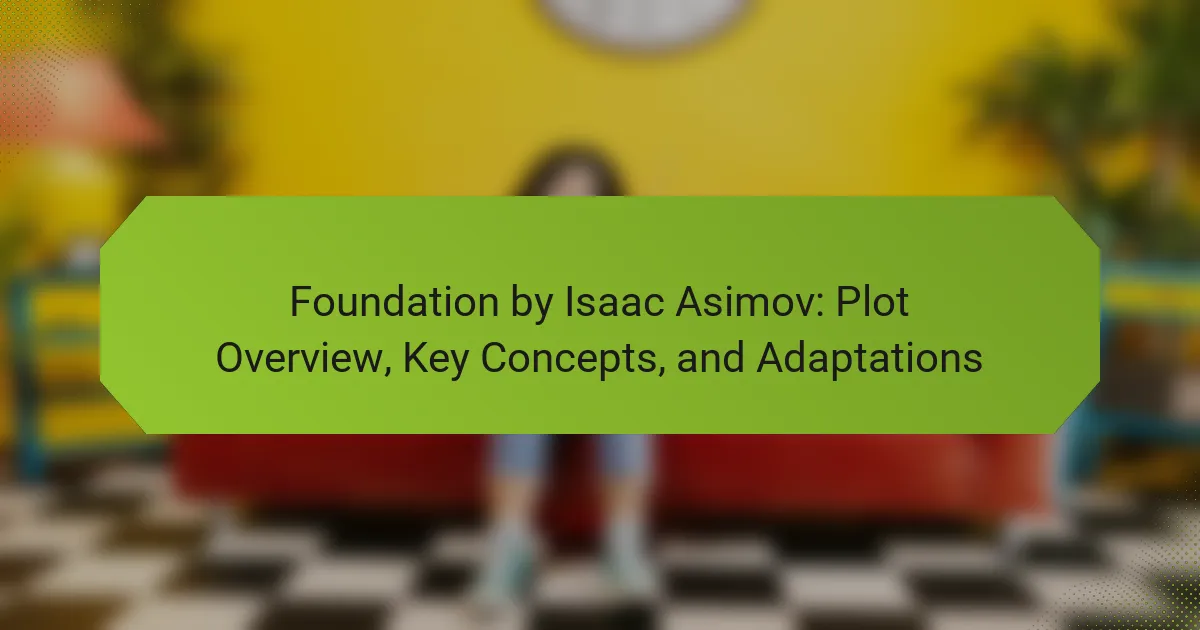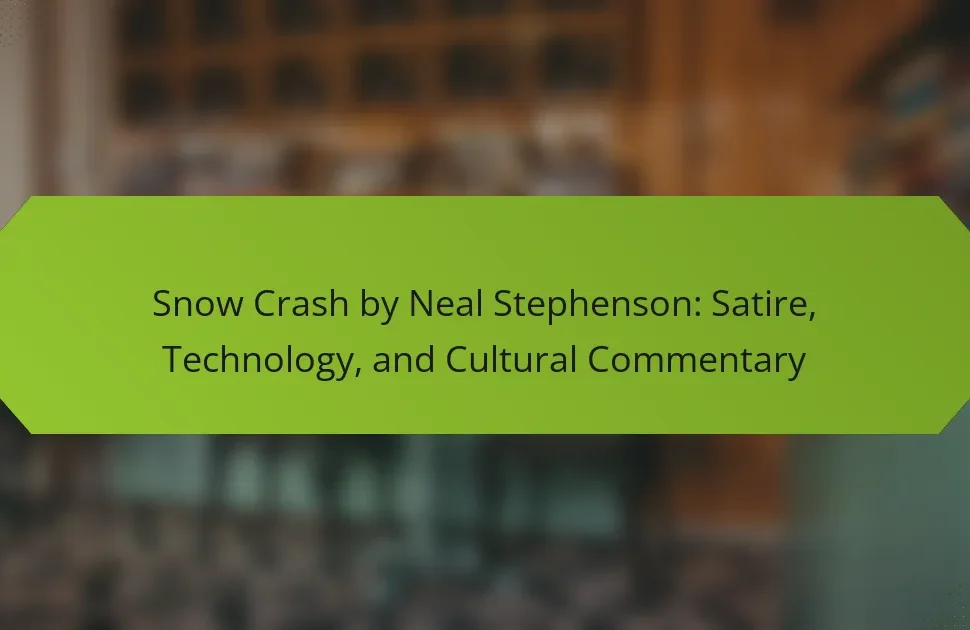Isaac Asimov’s “Foundation” delves into the complexities of civilization’s rise and fall. The article covers the plot overview, key concepts like psychohistory, and notable adaptations, including the Apple TV+ series. It highlights the cyclical nature of history and the importance of knowledge preservation in shaping the future. Additionally, it addresses common misconceptions surrounding the series and its broader influence on science fiction.

What are the main plot points of Foundation?
Foundation by Isaac Asimov follows key plot points that explore the rise and fall of civilizations. The story begins with Hari Seldon’s prediction of the Galactic Empire’s decline, leading him to establish the Foundation to preserve knowledge. Key events include the establishment of the Foundation, political intrigue with the Empire, and the emergence of the Mule, a unique mutant threatening Seldon’s plan. The narrative spans centuries, showcasing the Foundation’s growth and the challenges it faces, ultimately emphasizing the cyclical nature of history and the importance of foresight in governance.
How does the Galactic Empire influence the story?
The Galactic Empire significantly influences the story of Foundation by establishing a backdrop of decline and chaos. Its bureaucratic structure and oppressive governance set the stage for the rise of psychohistory, a scientific discipline that predicts societal trends. The Empire’s fall leads to the emergence of new powers and conflicts, shaping the trajectory of key characters and events. As a result, the narrative explores themes of power, control, and the cyclical nature of history. The Empire’s attributes, such as its vastness and authoritarian rule, create a unique environment that drives the plot forward.
What role does psychohistory play in the narrative?
Psychohistory plays a crucial role in “Foundation” by predicting the future of civilizations through mathematical laws. It combines history, sociology, and statistical analysis to foresee societal trends. This unique attribute allows characters to navigate crises effectively, shaping the narrative’s progression. As a result, psychohistory serves as the foundation for strategic planning and governance in the series, influencing key events and character decisions.
Which key characters drive the plot forward?
The key characters driving the plot of “Foundation” include Hari Seldon, Gaal Dornick, and the Mule. Hari Seldon, the creator of psychohistory, sets the foundation for the future of humanity. Gaal Dornick serves as Seldon’s apprentice, embodying the curiosity and intellect necessary to understand psychohistory. The Mule, a unique character with the rare ability to manipulate emotions, disrupts Seldon’s predictions, showcasing the unpredictability of human behavior. These characters are essential in navigating the complex themes of fate, power, and the cyclical nature of history.

What are the core themes explored in Foundation?
Foundation explores themes of psychohistory, the cyclical nature of history, the conflict between individual actions and societal trends, and the impact of technology on civilization. These core themes reflect Asimov’s insights into human behavior and societal evolution. The narrative emphasizes the importance of knowledge preservation and the role of science in shaping the future. Additionally, it examines the tension between determinism and free will, showcasing characters who navigate these complex dynamics.
How does Asimov address the concept of decline and fall?
Asimov addresses the concept of decline and fall through the rise and fall of civilizations in the Foundation series. He illustrates how societal decay is inevitable due to factors like political corruption and technological stagnation. The Galactic Empire’s decline serves as a backdrop, emphasizing the cyclical nature of history. Asimov uses psychohistory to predict and mitigate the effects of decline, suggesting that understanding patterns can help shape a better future.
What significance does technology hold in the series?
Technology plays a crucial role in “Foundation,” shaping societal structures and influencing the course of history. It serves as a tool for the scientific discipline of psychohistory, which predicts future events based on statistical analysis of human behavior. The interplay between technology and human decision-making highlights the series’ exploration of determinism versus free will. Additionally, advanced technologies like spaceships and robots illustrate the potential and risks of human innovation. Through these elements, Asimov emphasizes the significance of technology in shaping civilizations and their futures.

How has Foundation been adapted into other media?
Foundation has been adapted into various media, including television, film, and audio formats. The most notable adaptation is the Apple TV+ series, which premiered in September 2021. This series expands on the original narrative, introducing new characters and storylines while maintaining core themes. Additionally, there are audio dramas that explore different facets of the Foundation universe, enhancing the storytelling experience. These adaptations aim to reach wider audiences and breathe new life into Asimov’s seminal work.
What are the differences between the original text and the television adaptation?
The television adaptation of “Foundation” differs significantly from Isaac Asimov’s original text in narrative structure, character development, and thematic emphasis. The adaptation introduces new characters and alters existing ones, enhancing emotional depth and relationships. Additionally, it condenses timelines and events for pacing, which diverges from the book’s expansive world-building. Visual storytelling elements also play a crucial role, presenting a more immediate and dramatic interpretation of Asimov’s concepts.
How have film adaptations interpreted the source material?
Film adaptations of “Foundation” have varied interpretations of Asimov’s source material, emphasizing different themes and character arcs. The 2021 Apple TV+ series expands on character development and emotional depth, diverging from the original’s focus on ideas and concepts. The series introduces unique attributes, like personal stakes and relationships, which were less pronounced in the books. In contrast, earlier adaptations have struggled with capturing the complexity of the narrative, often simplifying key concepts. Overall, adaptations reflect a blend of fidelity to the source material and creative reinterpretation to appeal to contemporary audiences.

What unique elements set Foundation apart from other science fiction works?
Foundation distinguishes itself through its grand scale of time and ideas, exploring psychohistory and the rise and fall of civilizations. Unlike traditional narratives, it focuses on concepts over characters, emphasizing societal evolution and predictive modeling. The series integrates complex themes of knowledge preservation and the cyclical nature of history, offering a unique perspective on humanity’s future. Its influence extends to various adaptations, showcasing its enduring relevance in science fiction.
How does Asimov’s writing style contribute to the story?
Asimov’s writing style enhances the story through clarity, dialogue, and concise exposition. His straightforward prose allows complex ideas to be accessible, engaging readers effectively. The use of dialogue brings characters to life, showcasing their motivations and conflicts. Asimov’s ability to weave scientific concepts into the narrative fosters a sense of realism, grounding the speculative elements of the plot. This style supports the overarching themes of the Foundation series, emphasizing the interplay between knowledge and power.
What are the philosophical implications of psychohistory?
Psychohistory in Asimov’s Foundation series suggests a deterministic view of history, implying that societal trends can be predicted. This raises philosophical questions about free will versus determinism, the role of individual agency, and the ethical implications of manipulating societal outcomes. Psychohistory’s reliance on statistical laws challenges the notion of human uniqueness and autonomy, provoking debate on whether individuals can truly influence the course of history.

What are the common misconceptions about Foundation?
Many misconceptions exist about Isaac Asimov’s “Foundation.” One common belief is that it focuses solely on space battles; however, it primarily explores sociopolitical themes and the rise and fall of civilizations. Another misconception is that the series is purely science fiction; it integrates elements of history and psychology, emphasizing the importance of psychohistory. Additionally, some think the series is a straightforward narrative, while it actually comprises interconnected stories that span centuries, showcasing diverse characters and complex plots. Finally, many underestimate its influence, as “Foundation” has significantly shaped modern science fiction and inspired various adaptations, including television series and films.
Why do some readers misunderstand the role of the Mule?
Readers often misunderstand the Mule’s role due to its complex nature and unique abilities. The Mule, a mutant with the power to manipulate emotions, challenges the Foundation’s established order. This manipulation creates confusion, as readers may overlook the significance of emotional control in the broader narrative. Additionally, the Mule’s impact on the Foundation’s future is often misinterpreted, leading to misconceptions about its ultimate goals. Understanding the Mule requires recognizing its unique attribute of emotional influence, which is pivotal in shaping the events of the series.
What is often overlooked in character development?
Character development often overlooks the importance of internal conflicts. These struggles create depth and relatability, enhancing character arcs. In “Foundation,” Asimov emphasizes characters’ motivations and moral dilemmas, which shape their decisions and growth. This focus on internal conflict drives the narrative and engages readers effectively.
What practical insights can readers gain from Foundation?
Readers can gain insights on societal evolution, the impact of technology on civilization, and the importance of strategic foresight from Foundation. The narrative explores the rise and fall of empires, emphasizing how knowledge and planning can shape future outcomes. Key concepts include psychohistory, which combines history, sociology, and statistical mathematics to predict the future. Adaptations of Foundation in various media further illustrate its relevance and influence on contemporary storytelling and thought.




